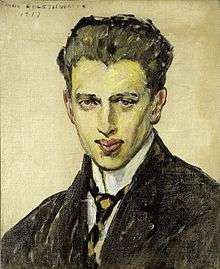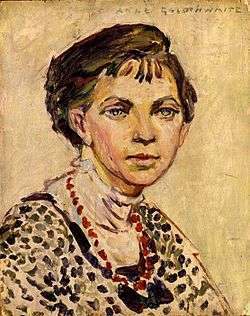Anne Goldthwaite
| Anne Goldthwaite | |
|---|---|
|
Self-portrait, c. 1906-1913, Smithsonian American Art Museum | |
| Born |
June 28, 1869 Montgomery, Alabama |
| Died |
January 29, 1944 New York |
| Cause of death | Illness |
| Residence | New York |
| Nationality | American |
| Education | Walter Shirlaw at National Academy of Design, Charles Guérin |
| Known for | Portrayal of southerners |
Anne Goldthwaite (1869–1944) was an American painter and printmaker and an advocate of women's rights and equal rights.[1]
Early life
Anne Goldthwaite was born in Montgomery, Alabama on June 28, 1869. Her father Richard W. Goldthwaite, served as an artillery captain for the Confederacy during the Civil War. Her family moved to Dallas, Texas and remained there for the majority of her childhood while her father looked for work.[2] Upon the death of her parents, Goldthwaite and her two sisters returned to Alabama to be cared for by various family members. Her aunt presented her to society as a promising young debutante who was destined to become a southern belle. This changed after her fiance was killed in a duel. While visiting Goldthwaite in Alabama, her uncle Henry Goldthwaite was impressed by her drawing and painting skills. To lift her spirits, he offered to support her financially for up to ten years if she relocated to New York City to study art. She enrolled at the National Academy of Design where she studied etching with Charles Mielatz and painting with Walter Shirlaw.[3]
Career
In 1906, Anne Goldthwaite traveled to Paris to explore her interest in the early modern painting styles of Fauvism and Cubism.[2] She met Gertrude Stein while sketching in the Luxembourg Gardens. According to Charlotte Rubinstein in American Women Artists, Goldthwaite explained that Stein "looked something like an immense dark brown egg. She wore, wrapped tight around her, a brown kimono-like garment and a large flat black hat, and stood on feet covered with wide sandals."[3] Stein invited Goldthwaite to visit her home, yet she hesitated due to Stein's "shabby" appearance. But Goldthwaite soon realized Stein's presence in the art world when encountering the extensive contemporary painting collection hung on the walls of her apartment.[3] Meeting one of the most influential pre-war avant-garde persons of the time gave Goldthwaite an opportunity to join the art circle of Henri Matisse and Pablo Picasso. She later said, "Fate gave me several years in Paris at the most exciting time: during the great reconstruction from art to modern art." During her time in Paris, Goldthwaite drifted to different studios in an attempt to find the right teacher. After much difficulty, she joined a small group of young artists who worked at 86 Notre Dame des Champs. Their work was periodically critiqued by Charles Guerin, a disciple of Cézanne. The group called themselves the Academie Moderne and held an exhibition each spring.[2]
Goldthwaite returned to America and contributed to the introduction of European Modernism in the 1913 New York Armory Show. She showed The Church on the Hill, (1910–11).[4] At the exhibition she met a fellow artist Kathrine Dreier, who would soon become a lifetime friend.[3] In 1915 she began to establish a consistent working schedule consisting of nine months in New York followed by the summer spent with family in Montgomery, Alabama. She began painting lovingly rendered portraits of her friends and family. Her sister Lucy, painter Rico Lebrun, and her first New York dealer Joseph Brummer, are just a few of these close subjects. Goldthwaite later became known as one of the South’s most important regional artists for her scenes of post-slave rural African American life. She documented the lifestyle with oil paintings, watercolors, and etchings. The Section of Painting and Sculpture awarded her two commissioned murals in Alabama for her lifelong exploration of this subject. She completed The Letter Box in Atmore, Alabama in 1937 and The Road to Muskegee in Tuskegee, Alabama in 1939.[5] Goldthwaite spent 23 years as a beloved teacher at the Art Students League of New York. She was also an active member of several artist organizations such as the New York Society of Women Artists, where she was appointed president in 1937-1938.[2] Goldthwaite’s work was brought to Edith Halpert, who focused on showing the work of American Modernists. Anne was given several one-woman shows in her Downtown Gallery in New York.[2] From 1922 until 1944, she taught and took commissions from her residence in New York. Amongst those who commissioned her work was Woodrow Wilson.
Anne Goldthwaite was an advocate of equal rights and women’s rights. She was actively involved in woman’s groups, and fought for equality in the south for ethnic minorities.
Later life
On January 29, 1944, Anne Goldthwaite died in New York after a long illness. Her funeral service and burial took place in Montgomery, Alabama.
Works


- A Window at Night, oil on canvas, c. 1933, Metropolitan Museum of Art[6]
- Avenue of the Allies (Fifth Avenue), etching on paper, 1918, Smithsonian American Art Museum[7]
- Business Section of Boquehomo, etching, not dated, Smithsonian American Art Museum[7]
- Cabin in Alabama, oil on canvas, c. 1915-1925, Smithsonian American Art Museum[7]
- Cow and Calf, drypoint, Cleveland Museum of Art[8]
- East Tenth Street, etching and drypoint, Cleveland Museum of Art[8]
- Garden Gate, Near Ascain #7, oil on canvas, 1912, Metropolitan Museum[6]
- Grazing, watercolor and black chalk on paper, Metropolitan Museum of Art[6]
- Head of a Negress, Rachel, glazed terracotta sculpture, c. 1929, Metropolitan Museum of Art[6]
- Her Daughter, (mother bathing her child), lithograph, not dated, Smithsonian American Art Museum[7]
- Horse and Rider, lithograph, not dated, Smithsonian American Art Museum[7]
- Mending III, lithograph, not dated, Smithsonian American Art Museum[7]
- Negro Woman at a Fountain, etching, not dated, Smithsonian American Art Museum[7]
- New Year's Night - Cafe Versaille, etching, not dated, Smithsonian American Art Museum[7]
- New York Harbor, etching, Cleveland Museum of Art[8]
- Night Series: Dog Baying at the Moon, lithograph, Cleveland Museum of Art[8]
- Nude Reading, lithograph, not dated, Smithsonian American Art Museum[7][8]
- Pool Room, lithograph, not dated, Smithsonian American Art Museum[7][8]
- Polo I, etching, Cleveland Museum of Art[8]
- Portrait of a Young Man, oil on canvas, 1913, Smithsonian American Art Museum[7]
- Sarah Eakin Cowan (1873–1958), watercolor on ivory, 1935, Metropolitan Museum of Art[6]
- Saturday, etching, not dated, Smithsonian American Art Museum[7]
- Self-Portrait, oil on wood mounted on fiber, c. 1906-1913, Smithsonian American Art Museum[7]
- Selma, lithograph, Cleveland Museum of Art[8]
- Southern Street, watercolor and graphite on paper, Metropolitan Museum of Art[6]
- Street Fiddler, lithograph, not dated, Smithsonian American Art Museum[7]
- The Green Sofa, oil on canvas, c. 1930-1940, Metropolitan Museum of Art[6]
- The Jaehne House, East 10th Street, New York, etching, Cleveland Museum of Art[8]
- Tulips, Cleveland Museum of Art[8]
- Two Black Crows, lithograph, not dated, Smithsonian American Art Museum[7][8]
- Untitled, (child on a donkey or mule), lithograph, not dated, Smithsonian American Art Museum[7]
- Untitled, (Ironing), lithograph, not dated, Smithsonian American Art Museum[7]
- Young Woman in White, oil on canvas, c. 1930s, Cleveland Museum of Art[8]
- White Mules on a Bridge, oil on canvas, c. 1930-1940, Metropolitan Museum of Art[6]
References
- ↑ Ausfeld, Margaret Lynn (2011). "Goldthwaite, Anne". In Marter, Joan. The Grove encyclopedia of American art. Oxford: Oxford University Press. pp. 348–350. ISBN 9780195335798. Retrieved 25 November 2014.
- 1 2 3 4 5 "Anne Goldthwaite". ArtArt.
- 1 2 3 4 Rubinstein, Charlotte Streifer (1986). American Women Artists. New York, New York: Avon Books. pp. 178–179.
- 1 2 1913 Armory Show 50th Anniversary Exhibition 1963 organized by Munson-Williams-Proctor Arts Institute, sponsored by the Henry Street Settlement, New York City, Library of Congress, Utica, 1963. Copyright not renewed.
- ↑ "Registry". www.newdealartregistry.org. Retrieved 2016-03-05.
- 1 2 3 4 5 6 7 8 Search: Goldthwaite. Collection online. Metropolitan Museum of Art. Retrieved May 26, 2014.
- 1 2 3 4 5 6 7 8 9 10 11 12 13 14 15 16 17 Search: Anne Goldthwaite. Smithsonian American Art Museum. Retrieved May 26, 2014.
- 1 2 3 4 5 6 7 8 9 10 11 12 Artists: Anne Goldthwaite. Cleveland Museum of Art. Retrieved May 26, 2014.
External links
| Wikimedia Commons has media related to Anne Goldthwaite. |
